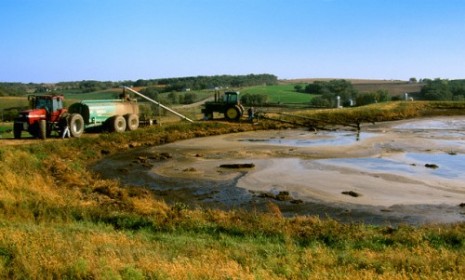Should America fear its giant 'poop bubbles'?
An Indiana dairy farmer confronts a new problem in the era of factory farms — bubbles of methane gas as big as a house

Indiana dairy farmer Tony Goltstein has an unmistakable problem. Twenty-foot-tall bubbles of methane gas have started bulging out of the pools where he collects manure from his 1,650 cows. Neighbors and state officials worry they'll explode and contaminate the air and water. Is this just one man's disgusting nightmare, or a typical consequence of factory-scale farming? Here are the facts about Goltstein's gas-bubble problem:
What are these "poop bubbles"?
Giant pockets of methane that have become trapped under the plastic liners in the vast "manure lagoons" at Goltstein's farm. The bubbles, which first appeared in 2006, are already 20 feet high, according to The Wall Street Journal, and could inflate even more even more as the accumulation of bovine waste continues to break down and release more methane.
The Week
Escape your echo chamber. Get the facts behind the news, plus analysis from multiple perspectives.

Sign up for The Week's Free Newsletters
From our morning news briefing to a weekly Good News Newsletter, get the best of The Week delivered directly to your inbox.
From our morning news briefing to a weekly Good News Newsletter, get the best of The Week delivered directly to your inbox.
What caused the bubbles?
A defect in the liners. Manure lagoons are common on large farms — businesses with a lot of livestock need a place to store decomposing animal waste until it can be used as fertilizer. Somehow, possibly through a tear in the plastic, waste and methane gas have been getting under Goltstein's liner.
What's he going to do?
Goltstein has a simple plan: Put his 19-year-old son in a rowboat, armed with a gas mask and a Swiss Army knife, and have him pop the controversial bubbles. Apprehensive state authorities have not okayed the scheme, however, and there is certainly an argument for caution: A manure-pit methane gas explosion in Hayfield, MN, blasted a hog farmer 40 feet into the air last year, leaving him with burns and singed hair.
A free daily email with the biggest news stories of the day – and the best features from TheWeek.com
Is there a more permanent solution?
"It's an excellent question," says David Kirby, author of Animal Factory:The Looming Threat of Industrial Pig, Dairy, and Poultry Farms to Humans and the Environment, in The Huffington Post. For years, neighbors have worried that Goltstein's bubbles would burst, filling the air with noxious fumes and releasing manure into the air and groundwater. Goltstein's Union Go Dairy business is bankrupt, so he can't afford the $200,000 it would take to replace the liner (the same sort used in landfills). The solution, Kirby says, is to require factory farms to purchase "a bond to cover any future environmental disaster they might cause," so taxpayers don't have to foot the clean-up bill.
Is there any way to make manure lagoons "green"?
Probably not. But giant agribusinesses, including Cargill, are experimenting with anaerobic digesters to convert methane from dairy farms into electricity. A new plant in Idaho — Cargill's second — uses manure from 6,000 cows to produce a million kilowatt-hours of electricity every month. That's enough to meet the energy needs of 1,100 U.S. homes.
-
 Five key changes from Rachel Reeves’ make-or-break budget
Five key changes from Rachel Reeves’ make-or-break budgetThe Explainer The chancellor is relying on a ‘smorgasbord’ of targeted revenue raisers to keep MPs, markets and voters onside
-
 Prisoner 951: ‘illuminating’ Nazanin Zaghari-Ratcliffe drama
Prisoner 951: ‘illuminating’ Nazanin Zaghari-Ratcliffe dramaThe Week Recommends 'Harrowing' tale of prison ordeal and an ‘unbreakable’ bond between husband and wife
-
 Crossword: November 26, 2025
Crossword: November 26, 2025The daily crossword from The Week